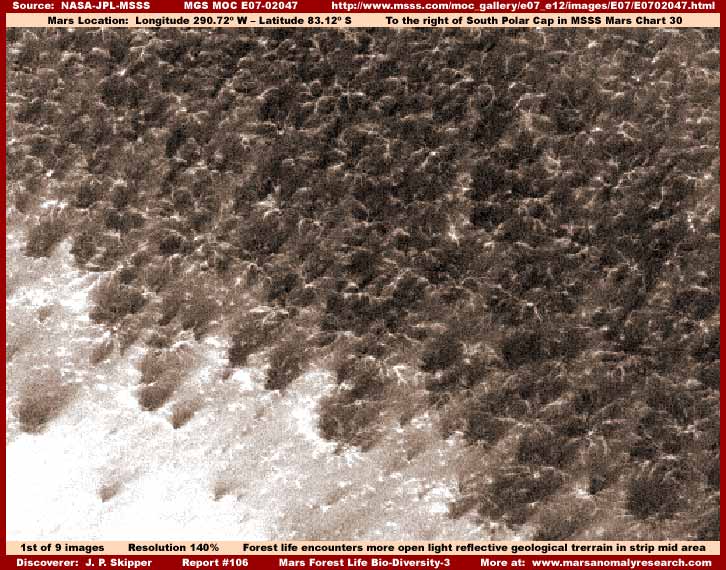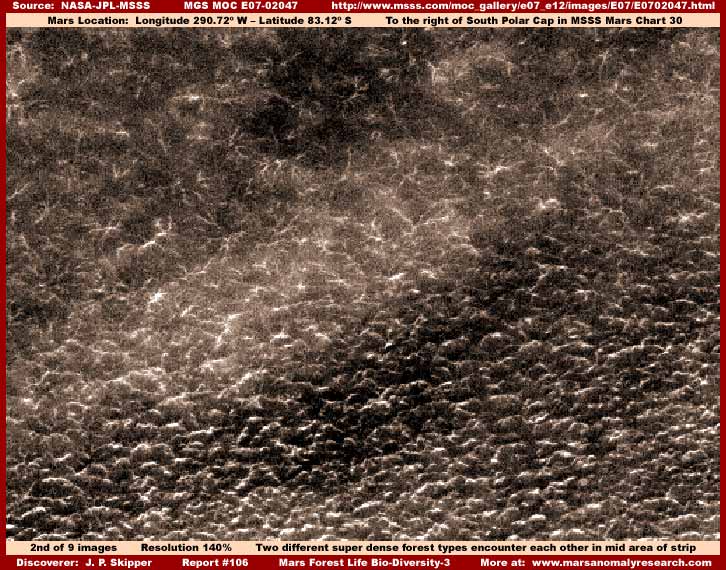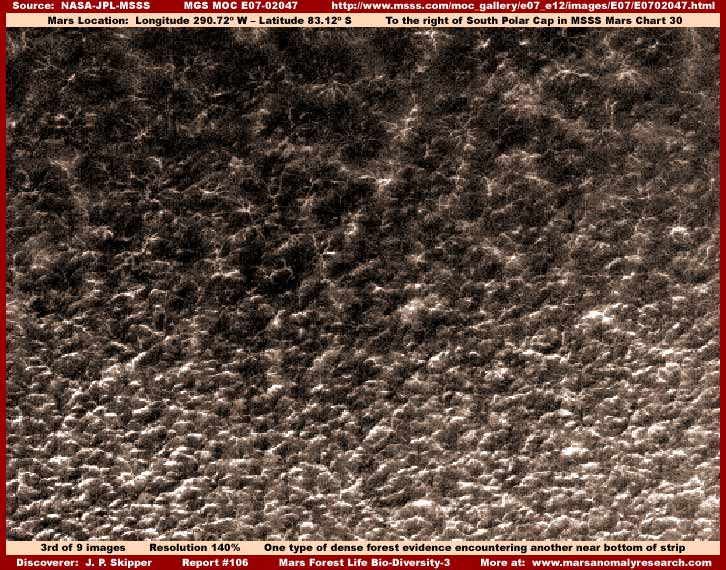
MARS FOREST LIFE BIO-
DIVERSITY-3a
Report #106
August 21. 2006

If you haven't already, suggest you visit and become familiar with the points raised in my Commentary #13 titled "Mars Forest Life Bio-Diversity" posted on the front page of the website to become familiar with some issues impacting this type of evidence.
Meanwhile, the above image is the first of three evidence images taken from the E07-02047 science data strip presented here in Part-1 of this 3-part report. In the above image, the darker color evidence is the forest life and the lighter color area in the lower left corner is the more bare light reflective terrain. The resolution is rather poor and obscuring things but this is also compounded by the branching feathery texture and merging nature of this smaller size forest life evidence that visually tends to intermingle and intertwine with itself making it difficult to pick out any individual object detail. The only thing that can be relied upon here is overall organized patterns typical of massed biological forest life.
The main reason I've included an image of this particular spot is because it demonstrates the boundary edge of the forest where it meets more open geological terrain providing contrast and insight into the difference between life and geology. Even with the poor resolution, this insight still comes across. True terrain geology, when one is looking at the genuine article, is almost always light reflective. It amazes me that scientists and academics can look at smudge image tampering that covers over and hides this light reflective quality in so much of the science data and still believe that they are looking a genuine terrain.
Unless the geological terrain is really rough and chaotic with an awful lot of jumbled and tumbled hard rocky surfaces in it, genuine bare terrain is most often normally devoid of massive numbers of hard objects and so the image files size is accordingly lower. As you can see in the bright reflective terrain in the lower left, it is relatively smooth. Therefore one might expect that the presence of such smoother terrain occupying part of the image will help lower the overall file size of this particular image and that is the case here.
The above image file size is relatively normal in size both because of the presence of this smoother geologic terrain and the branching intermingling quality of this particular type of forest pattern that tends to be counted by the software as just a huge mass as opposed to great numbers of better defined individual objects. The added insight is possible in my graphics work because for the most part all of my images are the same physical dimensions and so such information can be compared from image to image.

The above second image from the same E07-02047 science data strip taken from a mid area of the strip and demonstrates the same type of forest pattern in the above first image but here there is again a boundary because the same branching feathery type of forest is now bordering on and colliding with another completely different type of forest characterized by visually lumpy more pronounced individual objects. Both types of forest are densely packed and that is so typical of long life Mars South Polar Region forest evidence with its better ground water resources.
This where the scientist begin to really get very confused (I'm sure they would say the same about me) about what they are looking at. They might be suspicious that the upper branching evidence may be poorly seen forest life, without of course any kind of public admission, but they would be more inclined to believe that the lumpy harder surfaced objects without any more familiar looking branching members are just some kind of chaotic terrain geology. An example of that might volcanic lava extrusions that come out covering the terrain with folds and pillow shaped cooling rock. They see what they expect to see and, when in doubt, they expect to see and choose geology.
Now the file size of this image is beginning to climb up a bit, not too bad but a distinct increase. The poorly seen branching feathery evidence is keeping the file size down a bit relative to the lumpy evidence that is driving it up, so the net total file size is higher than for example the first image but still within reason. Believe me, if I had imaged only the lumpy evidence, the file size would have quickly went up dramatically.

The above third image is from a location down at the strip bottom and again shows another boundary area between these two different types of forest growth. The upper branching feathery forest type is more open forming shadows within its interior and this collectively causes it to look darker. The lower lumpy forest type is not branching and open but more self contained and smoother harder surfaced presenting an outer skin which means that it reflects light more and visually presents itself as a greater number of individual objects and this equates into higher individual object count in the graphics software.
Now the lower field of lumpy objects is a bit lighter in color here in my image than they are in the science data strip. That's a result of me lightening up the image trying to balance off giving a better look into the darker branching evidence. Why? Because the image at the very bottom of the strip is ever so slightly clearer than in the mid and upper areas. This partly because of the satellite orbital path in relation to the curvature of the planet's surface. In a fully intact strip, normally the strip mid area could be expected to be slightly clearer because it is normally slightly closer. That isn't the way it is with this strip being clearer near the bottom. This tells me that, even though this is a long strip, the original was no doubt much longer and the true mid area and bottom was no doubt cut off to eliminate a better closer view of this type of evidence and to facilitate better resolution degradation image tampering.
Should you be incline to wonder if the lumpy harder surfaced evidence really is merely chaotic terrain geology, go an inspect the whole science data strip at the link below. This demonstrates what I can't show you in the imaging here. This strip is a slice across this dense forestation that occupies the strip from side edge to side edge and top to bottom. Only these two forest types dominate and there is a large circular clearer area of bright light reflective geological terrain roughly in the middle of the strip that my first image above shows just a small part of.
You will see in this strip context overview that the lumpy looking evidence is very uniform in its texture pattern and obviously not to be confused with chaotic geological terrain. What you are looking at here is two different types of super dense forests, one more open in form and the other more tight and compact, that are competing for space with each other and for the most part completely covering the true more light reflective terrain geology from view. If the resolution in this science data imaging wasn't so degraded and inexcusably poor, we might be able to see that the more open forest life evidence is something that might be more familiar to our Earth human eyes (?) even though the tight and compact lumpy looking forest evidence is something new and unfamiliar looking to us.
I've included evidence from this strip in this report to demonstrate that both very different looking types of evidence exist not only on Mars but in the same physical areas competing for resources that both find favorable. The point is to not get confused that the most different looking evidence you will be seeing along and along is all just some kind of strange life form that specializes survival wise in Mars harsh hostile conditions, as those conditions are defined by current popular thinking. Rather the evidence you see here demonstrates that the life evidence here are both competing for the same favorable resources and very probably not unlike what we might expect to happen here on Earth with respect to water, minerals, air conditions, and solar radiation.
In other words, don't necessarily get the impression that strange unfamiliar looking to the Earth human eye life evidence you will be seeing is something adapted to harsh unusual conditions. Remember that the basic wooded type conventional forest evidence also previously presented here at this website indicates relatively normal environmental conditions that fly right in the face of the currently accepted science data. In reality, the more strange looking evidence has been seen before here on Earth, especially in petri dishes and labs, just not on the scale in the wild that is the case with Mars.
Now we're going to move on to Part 2 of this report at the link below. I'm having to break this report up into multiple parts because the next evidence is primarily the more unfamiliar looking lumpy kind and the file sizes on the next images is very high even though I have them compressed as much as possible. If I included all of this evidence in a single report, it would adversely effect report loading times for those on dial-up modems without high speed connections.
DOCUMENTATION
http://www.msss.com/moc_gallery/e07_e12/images/E07/E0702047.html: This link takes you to the official E07-02047 science data strip that is the source of my above first, second and third evidence images.
![]()